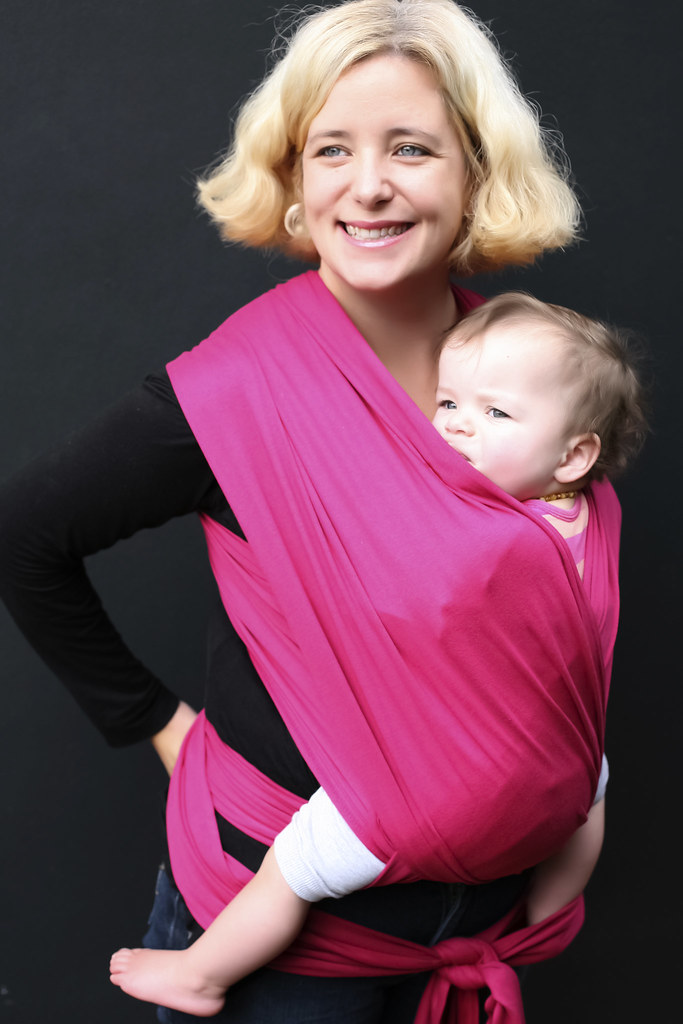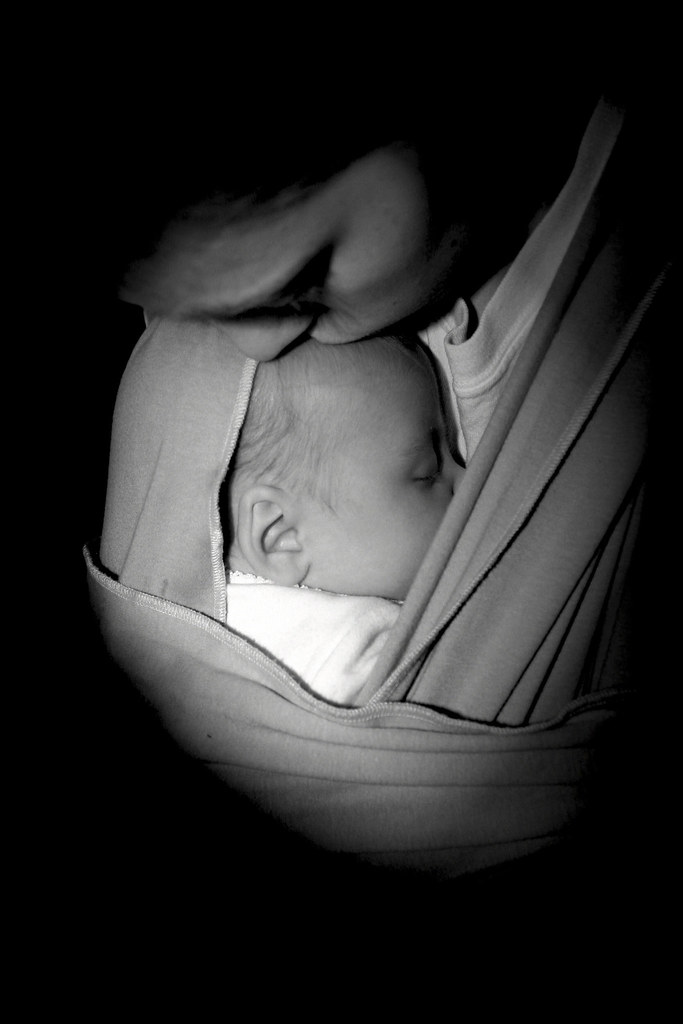Babywearing is SAFE!
Carrying a baby close to your center of senses, you will be able to sense a baby’s needs immediately. To make sure you follow this innate desire to keep your baby close without swaying with the trends of time, here are a few tips.
A lot of the safety measures are old hat in Germany where Dr. Kirkilionis has been valiantly keeping babywearing in the public’s eye through media, lectures, midwife organizations, etc.
Because of her unyielding efforts babies have been safe in Germany with 0 incidents over decades. Unfortunately in the USA we were saddened by 21 incidents in the past couple of decades. We realize we need a babywearing warrior like Dr. Kirkilionis in the USA and bring her knowledge to you in our babywearing education.
Upright and Wrapped Tight
The upright position is best for baby’s brain and hip development (legs out straddled around the babywearer’s body), breathing, spine development, and visibility.
When leaning forward you should be able to easily kiss your baby’s forehead.
Carrying baby upright allows baby to move his or her head easily without having to work against gravity. Babies carried upright show much better head control. Earlier than those not carried or carried in a cradle carry, which is considered a forced position.

A baby carrier should give the baby the secure feeling of being held in your arms. The carrier needs to embrace your baby tightly. When leaning forward baby should not fall into the fabric of the carrier but rather the babywearer and baby need to be one movement. If your baby falls into the fabric, your carrier needs to be tightened.
Make sure baby’s face is visible to you at all times. Take time to snuggle your baby frequently and gently check on your baby’s breathing.
Good carriers for newborns in upright positions are quality Woven Wraps and Ring Slings (with open tails and tested rings with sufficient size) because baby’s posture is held tightly upright with support on both sides of baby’s body.
The baby must not slouch into himself but rather is supported properly to allow for the natural movement of the baby without giving room to flop around in the carrier. The benefit of a woven wrap is that the baby feels secure to feel the boundaries rather than bouncing against a fabric that moves away from the baby.
There are also several imported newborn carriers on the market, most made of woven wrap fabric, that give the baby the proper support.
When your baby can sit unassisted you can still use woven wraps, ring slings, but also pouches, Mei Tais, podeigis, soft structured carriers, and onbuhimos.
Baby’s natural development needs to be supported to keep it from being in a forced position. Cradle carries have become popular, however, after the recall of a bag style sling we see a movement back to upright carries.
Of course it is possible to carry your baby safely in a cradle carry, however, it is important to monitor your baby constantly. Hence not a carrying way that can be used when running around without worry. To learn a proper cradle carry a certified babywearing educator should be consulted.
Keep in mind a cradle carry is a forced position. In it, a baby does not have the head control nor muscle strengths to move the head away, should the airway be obstructed or kinked as it is when the baby’s little chin rests on their chest.
A bag style sling‘s design is such that the baby will roll into himself with chin on the chest. Do not use bag style slings with newborns. If you want to use a bag style sling, use them as a hip carrier when your baby can already sit – but never in the cradle position!
To cradle or not to cradle

In a cradle position baby will gravitate to the lowest point in the carrier and through movement of the babywearer turn towards the babywearer’s body. A newborn’s spine is rounded, called kyphosis. In order to be rounded naturally, baby cannot bend sideways around the babywearer’s body and will inevitably turn towards the babywearer.
Slings supporting the cradle carry only, often are designed to hold the baby so low on the babywearer’s body that any distress cannot immediately be recognized. Unfortunately a lot of the cradle slings cover baby’s face completely. This is a potential death trap. Do not use this kind of sling!
See new research from professionals at hipdysplasia.org. It beautifully shows what we have been teaching for years. The cradle carry is a high risk carry for positional asphyxiation but also for the healthy hip development. Best practice is upright embraced tight! Click on the link to see how the experts agree on what constitutes safest practice in babywearing. Perfect illustrations of good baby carriers by experts.
Certified Babywearing Educators
A babywearing educator can help you choose the carrier that will best fit your baby and your needs. They have taken special interest in babywearing education and we are confident will give you expert advise.
Positional Asphyxiation – what is it?
Positional Asphyxiation is a phrase that has been thrown around the Internet with the recalls of baby slings.
It is essentially a kink in the airway. Baby’s chin hits his chest and kinks the airway. The baby cannot breathe and dies within 3-5 minutes without making a sound. The baby’s head is too heavy for him to lift it out of a compromised position like the cradle carry.
Upright, wrapped tight, chest to chest is best!
There has been much discussion about the proper positioning of baby in a baby carrier.
Manufacturers of pouches and cradle-only carriers argue that their products are safe. We see manufacturers explain their products ‘are safe for newborns if…’ and then there is a list of things that need to be done in order to keep the baby safe in a position that will not compromise baby’s airway.
Adding items to the carrier however also adds a hazard. Anything placed in a baby carrier leads to a greater suffocation and positional asphyxiation risk.
In March 2010 the Consumer Product Safety Commission warned about the use of baby carriers. Recent incidents of babies suffocating in products that were meant to keep them safe and secure, made it necessary for the CPSC to issue warnings.
Unfortunately the warnings were about baby carriers in general when the real problem are carries that support baby in a cradle carry.
Manufacturer and some educators insist that cradling a baby in a carrier just mimics baby being held in arms. This unfortunately is misleading as a baby cradled in arms does not stay in the same position for extended periods of time. A baby in arms gets shifted around frequently and the person carrying the baby is much more aware of baby’s breathing than a baby in a cradle carrier, especially with the ones available on the market where baby is so far removed from the babywearer’s senses as they dangle by your belly button or hip.
Working with the CPSC we reviewed all incidents in the past twenty years in the USA and this is what we found.
The most critical age for babies dying of positional asphyxiation is from 0-4 month. The most critical position, with by far the most incidents, is once again the cradle carry. We were saddened and terrified just reading the facts leading up to baby’s death in a baby carrier!
The devastation of the parents weigh heavy on our spirits and we vowed to educate anybody and everybody we come in contact with about the dangers of all cradle carry carriers.
Let’s look at the statistics.
Babies under 4 month are the greatest risk group. A baby carrier needs to take into consideration that baby cannot hold his head up, the muscle tone is by far not enough to help baby out in a compromised position like the forced cradle carry.
Statistics clearly show that the cradle carry to be the position with the most babies suffocating due to positional asphyxiation or an object obstructing baby’s airway.
When looking at statistics of different types of carriers, most incidents happened in bag style slings followed by heavily padded ring slings that are not individually adjustable and then pouches. All of these cradle-carry-only devices, that might be used with an older one upright but are not adjustable, pose a suffocation hazard to your baby. Ring slings used in a cradle carry also pose a safety hazard.
To reiterate the most important point:
The cradle carry is a high risk carry and is better left unused. There are many carriers on the market that will allow for upright carrying and are by far safer than any cradle carry carrier.
What is wrong with telling parents to pick carriers that mimic the in-arms holding of babies?
A lot of manufacturer and so called babywearing advocates or self proclaimed educators, will tell parents that a baby carrier is supposed to mimic in-arms holding of the baby. Of course always supporting the cradle carry, which is in and of itself a high risk carry.
Why is this theory flawed?
A parent never holds a baby in the same position for several hours. When baby is held in arms, baby gets shifted around numerous times every few minutes. Positional asphyxiation can happen within 3-5 minutes without baby making a sound.
In arms baby gets shifted around every 2-5 minutes and positional asphyxiation is very unlikely. The suffocation cases we read were all when baby fell between the parent and a chair or couch and suffocated there, not from being held in arms.
In 20 minutes of in-arms holding, baby gets shifted around approximately 1 5-17 times. No baby carrier can copy that!
Observe yourself next time you carry your baby in-arms. How often do you shift your baby? Does it stay in the same place long enough to suffocate like in a carrier that keeps baby in the same position for hours?
Below you can see just a small selection of babies carried in different poses in-arms. Some facing out as well because it is easier to hold baby facing out leaning against your body. Facing out is never advised in a carrier because baby would be in it for long periods of time which is absolutely not favorable for baby’s hip and spine. Being held in arms, baby is facing out for seconds or minutes at most, never hours!







Conclusion:
Baby carriers need to be safe, patterned after what has worked and is working around the world with 0 fatalities and healthy hips and spines.
The in-arms mimic was invented to still allow unsafe carriers to be promoted, mainly for the cradle carry, which is proven to be a high risk position.
We are for safest humanly possible babywearing and only teach that. We will not walk a gray line of what can be done but rather we will stay away from anything that can pose a safety hazard to your child. Cradle carry and the misleading in-arms gimmick are two of those.


